
The Journal of Charles W. Cook
The Letters of George Henry Moulton
Researching at the National Archives
Milton in the Civil War
George's Island Historical Tour
|
|
The War of the Rebellion — The Great Civil War
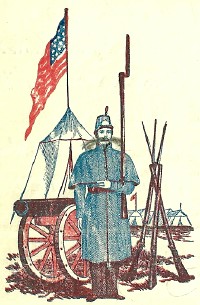 The first call to arms was received from Washington, by telegram, at the Massachusetts Governor's office on the 15th day of April 1861. It asked for 20 companies (fifteen hundred soldiers) to be sent forward at once. Many believed the 'Rebellion' would be short lived and the federal government would prevail, but by the summer of 1862 the Union's 'Army of the Potomac' had failed in its objective to capture Richmond. The first call to arms was received from Washington, by telegram, at the Massachusetts Governor's office on the 15th day of April 1861. It asked for 20 companies (fifteen hundred soldiers) to be sent forward at once. Many believed the 'Rebellion' would be short lived and the federal government would prevail, but by the summer of 1862 the Union's 'Army of the Potomac' had failed in its objective to capture Richmond.
President Lincoln, on July 4, 1862, called for three hundred thousand troops. Massachusetts created nine new three-year regiments (from the 33rd to the 41st regiments), contributing fifteen thousand troops to the war effort. The following month, on August 4th, the President issued a call for an additional three hundred thousand troops to serve nine month tours and to be raised by draft if necessary. Massachusetts responded by activating seventeen of its state militia regiments thus enabling the state to meet its quota of 19,090 troops.
By war's end, in 1865, more than 300 Milton townsmen had served the Union cause and some 30 of "our fallen heroes" are memorialized in Teele's The History of Milton.
The Journal of Charles W. Cook
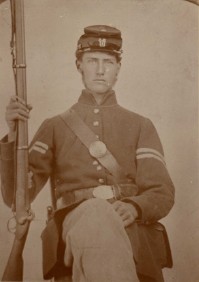 Charles W. Cook, a resident of Milton and a civil war soldier, kept a journal. The journal's whereabouts are currently unknown but a transcript or chronology of entries excerpted from the journal has existed from at least the early 1960s when a copy was given to me by my uncle, Charles Bent. Cook, my great-great grandfather, was a corporal assigned to Company E, 35th Regiment, Mass Volunteer Infantry. The 35th, one of the three year regiments, consisted of 1,013 officers and enlisted men making up ten companies. Company E drew its recruits from the towns of Milton, Randolph, Stoughton and Canton. The journal spans less than a month's time but gives a firsthand account of Cook's participation and observations at the battle of Antietam - the bloodiest single day in American history; culminating in more than 23,000 casualties. Charles W. Cook, a resident of Milton and a civil war soldier, kept a journal. The journal's whereabouts are currently unknown but a transcript or chronology of entries excerpted from the journal has existed from at least the early 1960s when a copy was given to me by my uncle, Charles Bent. Cook, my great-great grandfather, was a corporal assigned to Company E, 35th Regiment, Mass Volunteer Infantry. The 35th, one of the three year regiments, consisted of 1,013 officers and enlisted men making up ten companies. Company E drew its recruits from the towns of Milton, Randolph, Stoughton and Canton. The journal spans less than a month's time but gives a firsthand account of Cook's participation and observations at the battle of Antietam - the bloodiest single day in American history; culminating in more than 23,000 casualties.
The transcript has been researched and footnoted and includes the military abstracts of the soldiers referenced in the journal with a short sketch of the Cook family. In commemoration of the 150th anniversary of the battle of Antietam, we've published it here.
— Dennis M. Doyle, MHS Historian
The Letters of George Henry Moulton
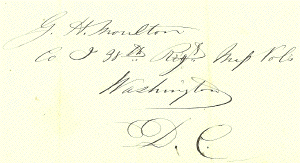 George Henry Moulton of Milton kept his commitment to "serve out" his "Three Year Enlistment," and over the course of it wrote to his family sixty-two letters, donated by great-grand nephew Robert Schaefer. Moulton often mentions "the Milton boys" in his outfit, including Walter Bradlee, Johnnie Cross, Chas Hunt, Hiram Nye, Charlie Thayer and others. He inquires of girls back home and asks to be remembered to some and not others who "don't have the time to return my mail." His patriotism is constant but his youthful bravado tempers as he experiences the reality and horror of war. The one- to two-page letters are devoid of grandiose and gore, and comment on food, religion, politics, and the war. Mostly, though, they describe the personal experience of a young soldier, and we invite you to partake of that experience. George Henry Moulton of Milton kept his commitment to "serve out" his "Three Year Enlistment," and over the course of it wrote to his family sixty-two letters, donated by great-grand nephew Robert Schaefer. Moulton often mentions "the Milton boys" in his outfit, including Walter Bradlee, Johnnie Cross, Chas Hunt, Hiram Nye, Charlie Thayer and others. He inquires of girls back home and asks to be remembered to some and not others who "don't have the time to return my mail." His patriotism is constant but his youthful bravado tempers as he experiences the reality and horror of war. The one- to two-page letters are devoid of grandiose and gore, and comment on food, religion, politics, and the war. Mostly, though, they describe the personal experience of a young soldier, and we invite you to partake of that experience.
Inspired by similar projects of the Massachusetts Historical Society, we emailed to interested members each of Moulton's letters, transcribed and footnoted, on its 150th anniversary. Occasionally, we filled in with research and Moulton's records from the National Archives. The gentle but persistent pace of the emailed letters, spanning almost three years, gave the recipients a personal, direct understanding of the era.
You can partake of that experience, too: the transcribed letters, our research, and Moulton's records from the National Archives can be found here, indexed chronologically. Start at the beginning; you will find it hard to stop.
Researching at the National Archives
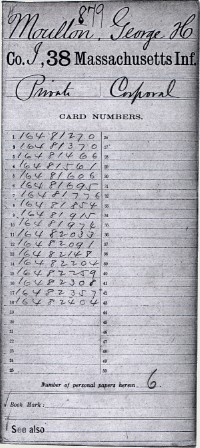 For anyone researching the millions of stories of Civil War soldiers, the National Archives and Records Administration can be a treasure trove. Below is a series of six articles by Claire Prechtel-Kluskens, first printed in the National Genealogical Society Magazine, itself an invaluable resource to amateur and professional genealogists. The articles describe the records available at the National Archives, how to access them, and how to dig even deeper, while telling the stories of just a few soldiers represented there. For anyone researching the millions of stories of Civil War soldiers, the National Archives and Records Administration can be a treasure trove. Below is a series of six articles by Claire Prechtel-Kluskens, first printed in the National Genealogical Society Magazine, itself an invaluable resource to amateur and professional genealogists. The articles describe the records available at the National Archives, how to access them, and how to dig even deeper, while telling the stories of just a few soldiers represented there.
- i. The Lightning Brothers: A Brief Case Study in Union Civil War Research
- ii. Thank You, General Fred C. Ainsworth!
- iii. Compiled Military Service Records Part I: The Records Inside the CMSR Jacket
- iv. Compiled Military Service Records Part II: The Records Outside the CMSR Jacket
- v. Compiled Military Service Records Part III: The Record of Events
- vi. Compiled Military Service Records Part IV: Carded Medical Records
- vi. Pension Payment Cards, 1907-1933, for Caroline S. Moulton
At left is the jacket of George Henry Moulton's Compiled Military Service Record. The documents inside complement his letters by giving the Army's perspective: musters, a hospital stay, clothing, and pay reconciliation. As described in Claire's fourth article, though, it was in the unfiled records outside this jacket where she found the CMSR card most valuable to us: his enlistment description, which remains our only source of what the young man looked like.
Milton in the Civil War
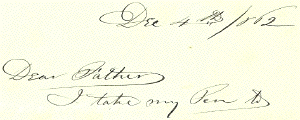 On Thursday, November 10, 2011, at 7pm, at the Milton Council on Aging, 10 Walnut Street, we presented our first commemoration of Milton's participation in the Civil War, in honor of Veterans Day and all veterans. Our historian, Dennis M. (Mike) Doyle gave an interactive lecture on the experiences of Milton soldiers, interspersed with readings from letters and journal entries. As Mike recounted the paths of the Boston Cadets, the 35th, and the 38th Massachusetts Volunteers, each member of the audience was given the identity of one of the Milton soldiers in those groups, learning only at the end the fate of the soldier. For those who wish to learn more, the journal of Charles Cook of the 35th, and the letters of Henry Moulton of the 38th will be released by the society (see above). The Boston Cadets, before being sent out as line officers, served together at Fort Warren on Georges Island. The New York Times recently ran an article about Fort Warren in the Civil War. On Thursday, November 10, 2011, at 7pm, at the Milton Council on Aging, 10 Walnut Street, we presented our first commemoration of Milton's participation in the Civil War, in honor of Veterans Day and all veterans. Our historian, Dennis M. (Mike) Doyle gave an interactive lecture on the experiences of Milton soldiers, interspersed with readings from letters and journal entries. As Mike recounted the paths of the Boston Cadets, the 35th, and the 38th Massachusetts Volunteers, each member of the audience was given the identity of one of the Milton soldiers in those groups, learning only at the end the fate of the soldier. For those who wish to learn more, the journal of Charles Cook of the 35th, and the letters of Henry Moulton of the 38th will be released by the society (see above). The Boston Cadets, before being sent out as line officers, served together at Fort Warren on Georges Island. The New York Times recently ran an article about Fort Warren in the Civil War.
The program included music of the Civil War period performed by Emma Jean Moulton and ended with a ceremonial reading by Selectman John Michael Shields of the names of those from Milton who sacrificed their lives in the Civil War.
George's Island Historical Tour
On September 8th, 2012, we toured the Civil War-era Fort Warren with Mike Doyle, Milton Historical Society historian and Department of Conservation and Recreation Park Ranger Supervisor.
If you missed it, George's Island is open through October with tours of Fort Warren every day. It's best to buy your ferry tickets ahead of time, either online or by calling Boston's Best Cruises at 617-770-0040 (look over the schedule at bostonharborislands.org/ferry-schedule-spring-fall).
The islands host many events, so check their calendars, and you might catch things like Civil War-era baseball games played with original rules and uniforms, music concerts, and even beer tastings.
|


 The first call to arms was received from Washington, by telegram, at the Massachusetts Governor's office on the 15th day of April 1861. It asked for 20 companies (fifteen hundred soldiers) to be sent forward at once. Many believed the 'Rebellion' would be short lived and the federal government would prevail, but by the summer of 1862 the Union's 'Army of the Potomac' had failed in its objective to capture Richmond.
The first call to arms was received from Washington, by telegram, at the Massachusetts Governor's office on the 15th day of April 1861. It asked for 20 companies (fifteen hundred soldiers) to be sent forward at once. Many believed the 'Rebellion' would be short lived and the federal government would prevail, but by the summer of 1862 the Union's 'Army of the Potomac' had failed in its objective to capture Richmond.
 George Henry Moulton of Milton kept his commitment to "serve out" his "Three Year Enlistment," and over the course of it wrote to his family
George Henry Moulton of Milton kept his commitment to "serve out" his "Three Year Enlistment," and over the course of it wrote to his family  For anyone researching the millions of stories of Civil War soldiers, the
For anyone researching the millions of stories of Civil War soldiers, the  On Thursday, November 10, 2011, at 7pm, at the Milton Council on Aging, 10 Walnut Street, we presented our first commemoration of Milton's participation in the Civil War, in honor of Veterans Day and all veterans. Our historian, Dennis M. (Mike) Doyle gave an interactive lecture on the experiences of Milton soldiers, interspersed with readings from letters and journal entries. As Mike recounted the paths of the Boston Cadets, the 35th, and the 38th Massachusetts Volunteers, each member of the audience was given the identity of one of the Milton soldiers in those groups, learning only at the end the fate of the soldier. For those who wish to learn more, the journal of Charles Cook of the 35th, and the letters of Henry Moulton of the 38th will be released by the society (see above). The Boston Cadets, before being sent out as line officers, served together at Fort Warren on Georges Island. The New York Times recently ran an article about
On Thursday, November 10, 2011, at 7pm, at the Milton Council on Aging, 10 Walnut Street, we presented our first commemoration of Milton's participation in the Civil War, in honor of Veterans Day and all veterans. Our historian, Dennis M. (Mike) Doyle gave an interactive lecture on the experiences of Milton soldiers, interspersed with readings from letters and journal entries. As Mike recounted the paths of the Boston Cadets, the 35th, and the 38th Massachusetts Volunteers, each member of the audience was given the identity of one of the Milton soldiers in those groups, learning only at the end the fate of the soldier. For those who wish to learn more, the journal of Charles Cook of the 35th, and the letters of Henry Moulton of the 38th will be released by the society (see above). The Boston Cadets, before being sent out as line officers, served together at Fort Warren on Georges Island. The New York Times recently ran an article about